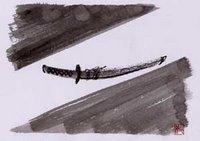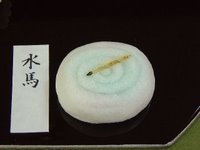:::::::::::::::::::::::::::::::::::::::::::::::::::::::::::::::::::::::::::::::::::::::::::::::::::::
Whales, Walfisch (kujira)
***** Location: Japan, other areas
***** Season: See below
***** Category: Animal
*****************************
Explanation
Whale, kujira 鯨
kigo for all winter in Japan
semi kujira 背美鯨(せみくじら)Eubalaena japonica
makkoo kujira 抹香鯨(まっこうくじら)sperm whale
Physeter macrocephalus
zatoo kujira 座頭鯨(ざとうくじら)humpback whale
Megaptera novaeangliae
iwashi kujira 鰯鯨(いわしくじら)sei whale
Balaenoptera borealis]
nagasu kujira 長須鯨(ながすくじら)
Balaenoptera musculus
..... shironagasu kujira 白長須鯨(しろながすくじら)
kokujira 小鯨(こくじら)"small whale"
isana 勇魚(いさな)Isana. old name for the whale

.................................................................................
humanity kigo for all winter

. hokei 捕鯨 (ほげい) whaling, whale hunting
kujira tsuki 鯨突(くじらつき)spearing a whale
isana tori 勇魚取(いさなとり)
kujirabune 鯨舟(くじらぶね)whaler, boat for whaling
..... hokeisen 捕鯨船(ほげいせん)
kujirami 鯨見(くじらみ)outlook for whales
..... kujiraban 鯨番(くじらばん)
ichiban mori 一番銛(いちばんもり)first harpoon
niban mori 二番銛(にばんもり)second harpoon
.................................................................................

kujiranabe 鯨鍋 (くじらなべ) whale hodgepodge
kujirajiru 鯨汁(くじらじる)soup with whale meat
:::::::::::::::::::::::::::::::::::::::::::::::::::::::::::::::::::::::::::::::::::::::::::::::::::::
humanity kigo for all summer

shio kujira 塩鯨(しおくじら) salted whale meat
sarashi kujira 晒鯨 (さらしくじら) salted whale meat
kawa kujira 皮鯨(かわくじら)whale skin
Matsuo Basho wrote in "Kuzu no Matsubara" 葛の松原
水無月や鯛はあれども塩鯨
minazuki ya tai wa aredomo shiokujira
in June
having salted whale is better than
sea bream
Tr. Reichhold
Sixth Month--
though there is sea bream
this pickled whale meat
Tr. Barnhill
Barnhill comments:
"Sea bream is more of a delicacy, but for Basho what fits the season and his aesthetics is the lighter fare of cold, white whale meat favored by the common people."

source : turbobf1516
During the Edo period, a lot of whale was landed in Nagasaki (Hirado, Ikitsuki and the Goto islands) and prepared with salt to last on the long way via the Nagasaki Kaido road 長崎街道 or the Hirado Kaido 平戸街道 road to find its way to Edo.
Even now Shio-Kujira is served in many schools in Nagasaki, with grated onions and marinated in soy sauce. It is also deep-fried as tatsuta age.
Whale meat revived in Nagasaki
source : david-in-tokyo.blogspot
minazuki 水無月 "month without water"
This refers to the time just before the rainy season when water is scarce in the wells and fields.
- - - - - another reading is
mizu no tsuki 水の月 "month with water"
sixth lunar month, now July
. Matsuo Basho 松尾芭蕉 - Archives of the WKD .
:::::::::::::::::::::::::::::::::::::::::::::::::::::::::::::::::::::::::::::::::::::::::::::::::::::
WDCS is the global voice for the protection of whales,
dolphins and their environment
Introduction to Scientific Whaling
In 200O, Japan's research whaling fleet returned home with 88 whales out of the 160 planned to be killed in the north-western Pacific Ocean. In 2001, Japan began its programme to sample up to 100 minkes, 50 Bryde's and 10 sperm whales in the north-western Pacific Ocean, based on the country's spurious argument that whales are competitors with humans for dwindling fish resources. This hunt was on top of the 500 plus minke whales that it is already hunting in the Southern Ocean Sanctuary and the North Pacific.
The use of 'scientific permits' within the IWC is a controversial subject. Whilst Article VIII of the ICRW allows for a member nation to self-allocate quotas for 'scientific purposes', the majority of the IWC members believe that Japan and Norway, have abused this 'loophole' in the Convention.
Whilst many nations have used scientific permits to keep their struggling whaling industries alive, scientific permits really came into their own in the 1970s. The Faroese used scientific permits to maintain their commercial fin whale fishery, despite official IWC protection for the North Atlantic fin whale from 1976. In April 1985, the Japanese Minister for Fisheries, Moriyoshi Sato said, "the government (of Japan) will do its utmost to find ways to maintain the nation's whaling in the form of research or other forms". Japan began its scientific whaling programme in 1987, and continues to kill up to 540 minke whales every year. In 2000, it expanded its hunt in the North Pacific to include sperm and Bryde's whales.
The Japanese whaling programme has been repeatedly condemned by the International Whaling Commission. In 1995 the IWC recommended that members "should...refrain from issuing [scientific] permits in sanctuaries involving the killing of cetaceans in such sanctuaries" (IWC/47/30, Rev.1). The IWC also passed a resolution recommending that "scientific research intended to assist the comprehensive assessment of whale stocks and the implementation of the Revised Management Procedure "shall be undertaken by non-lethal means" (IWC/47/31).
On the 11th December 1995, the US Secretary of Commerce certified Japan under the 1978 Pelly Amendment to the Fisherman's Protective Act of 1967, noting that "Japanese nationals are engaged in scientific whaling activities that diminish the effectiveness of the International Whaling Commission (IWC) conservation program".
http://www.wdcs.org/dan/publishing.nsf/allweb/784FDCC28FBB876080256F3500551521
*****************************
Worldwide use
Alaska
humpback whales return home from Hawaii
kigo for spring
:::::::::::::::::::::::::::::::::::::::::::::::::::::::::::::::::::::::::::::::::::::::::::::::::::::
Hawaii
whale watching

especially in Hawaii, it is a big attraction.
There is also some whale watching going on in Japan.
Whales might be seen during the whole year, but during the summer holidays the whale watching is most prominent, therefore it might be considered
humanity kigo for all summer
Whale Watching
Check the Whale-Watching-Web
http://www.helsinki.fi/~lauhakan/whale/
Whale Watching World Wide
*****************************
Things found on the way

Moby Dick モビー・ディック
Moby-Dick; or, The Whale
was written by American author Herman Melville and first published in 1851.
It is considered to be one of the Great American Novels and a treasure of world literature.
© More in the WIKIPEDIA !
inspired by lines from Melville's "Moby Dick"
Growing grim
cold November in my soul
waiting for spring
William Sheehan
Joys of Japan, February 2012
:::::::::::::::::::::::::::::::::::::::::::::::::::::::::::::::::::::::::::::::::::::::::::::::::::::::::::::::::::::::::::
- Walfang -
Die Geschichte des Walfangs in Japan reicht weit in die Vergangenheit, erste Beschreibungen finden sich bereits im Kojiki , der ältesten Geschichtschronik des Landes aus dem achten Jahrhundert. Im 17. Jh. war die Stadt Taiji in Wakayama der Mittelpunkt des Walfangs mit Handharpunen.
Alle Teile eines Wals wurden verwertet, vom Fett über Fleisch bis zu den Knochen und Kiemen. Ein altes Sprichwort sagt: "Vom Walfisch gibt es nichts wegzuwerfen, nur seine Stimme."
Seit Ende des 19. Jahrhunderts wurden moderne Methoden des Fischfangs vom Westen übernommen. Während der Lebensmittelknappheit nach dem Zweiten Weltkrieg war billiges Walfleisch eine wichtige Nahrungsquelle und wurde auch als Mittagessen in Schulen gereicht.
Im Jahre 1962 betrug die Fangmenge von Walen 226 000 Tonnen, sank aber bald ab. Die Internationale Walfangkommission sprach 1986 ein Verbot für den kommerziellen Walfang aus. Japan umgeht dieses Verbot seither dadurch, dass man den Walfang als wissenschaftliches Forschungsprogramm deklariert.
*****************************
HAIKU
大航海時代終りし鯨かな
daikookai jidai owarishi kujira kana
the time of great seafarers
is now over -
all these whales
Hashimoto Eiji 橋本榮治 (1953 - )
:::::::::::::::::::::::::::::::::::::::::::::::::::::::::::::::::::::::::::::::::::::::::::::::::::::
Whale's fluke
tosses water up -
the memory of it...
Zhanna P. Rader
:::::::::::::::::::::::::::::::::::::::::::::::::::::::::::::::::::::::::::::::::::::::::::::::::::::
A whale!
Down it goes, and more and more
up goes its tail!
Buson, Yosa (1716-84)
Followed after Basho, but with his own style.
The whale squirts water
Don't kill the whale he is nice
He likes everyone.
Donny - third grade student
© Greenpeace, Haiku Contest 2006
Read the whole collection HERE !
My four year old son
says he wants to change the world
he's heard the whale's song...
Posted by: Jennifer Cherkasov at January 26, 2006
source: weblog.greenpeace.org, MORE : Haiku Contest 2006
:::::::::::::::::::::::::::::::::::::::::::::::::::::::::::::::::::::::::::::::::::::::::::::::::::::
deep blue --
in front of the whale
migration route
tons of tenderness --
a baby whale on the back
of its mother
Davorka Lukas, Croatia
June 2009
*****************************
Related words
***** ..... FISH as a kigo

Utagawa Hiroshige
***** yamakujira 山鯨(やまくじら) "whale of the mountain"
. Wild Boar (inoshishi)
[ . BACK to WORLDKIGO . TOP . ]
:::::::::::::::::::::::::::::::::::::::::::::::::::::::::::::::::::::::::::::::::::::::::::::::::::::













